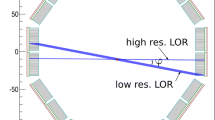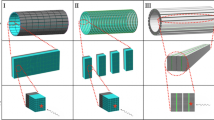Abstract
A proposal is made for the test conditions to evaluate PET count rate performance. This performance depends in a complex manner on the spatial distribution of activity and scattering material. Therefore, a combined body phantom is proposed, which is as simple as possible but which adequately simulates the range of clinical application of a whole body tomograph. Taking into account the special properties of the new block detector design, a comprehensive test procedure is developed. This includes not only the common count rate characteristic, but also checks for the accuracy of randoms estimation and count loss correction schemes, and for the occurence of pulse pile up. This is done for different source and scatter configurations, simulating brain, cardiac, and abdominal imaging, respectively. Examples are given, based on measurements of the latest generation PET scanners, namely the CTI PT 931/08-12 and the Scanditronix PC 2048-07WB.
Similar content being viewed by others
References
Bellina CR, Spinks T, Guzzardi R (1987) Corrections of dead time losses in positron tomography. J Nucl Med All Sci 31:17 (abstr)
CTI (1986) Specifications of the PT 931/08-12 PET scanner. Computer Technology and Instruments, Knoxville, Tennessee
Germano G, Hoffman EJ (1988) Investigation of count rate and dead time characteristics of a high resolution PET system. J Comput Assist Tomogr 12:836–846
Hoffman EJ, Huang SC, Phelps ME, Kuhl DE (1981) Quantitation in positron emission computed tomography: 4. Effect of accidental coincidences. J Comput Assist Tomogr 5:391–400
Hoffman EJ, Phelps ME, Huang SC (1983) Performance evaluation of a positron tomograph designed for brain imaging. J Nucl Med 24:245–257
Holte S, Eriksson L, Larsson JE, Ericson T, Stjernberg H, Hansen P, Bohm Chr, Kesselberg M, Rota E, Herzog H, Feinendegen L (1988) A preliminary evaluation of a positron camera system using a weighted decoding of individual crystals. IEEE Trans Nucl Sci 35:730–734
Jordan K, Newiger H (1987) A new flood phantom to measure homogeneity of gamma cameras and to correct SPECT studies. Eur J Nucl Med 13:327–330
Jordan K, Knoop BO (1988) Cardiac nuclear medicine tomographic systems. Eur J Nucl Med 13:612–618
Knoop BO, Newiger H, Gettner U, Jordan K, Geworski L (1988) Is counting statistics improved by deadtime losses? In: Schmidt HAE, Csernay L (eds.) Nuklearmedizin. Schattauer, Stuttgart, p 19
Mazoyer BM, Roos MS, Huesman RH (1985) Dead time correction and counting statistics for positron tomography. Phys Med Biol 30:385–399
Thompson CJ, Meyer E (1987) The effect of live time in components of a positron tomograph on image quantification. IEEE Trans Nucl Sci 34:337–343
Yamamoto S, Amano M, Miura S, Iida H, Kanno I (1986) Deadtime correction method using random coincidence for PET. J Nucl Med 27:1925–1928
Author information
Authors and Affiliations
Rights and permissions
About this article
Cite this article
Knoop, B.O., Jordan, K. & Spinks, T. Evaluation of PET count rate performance. Eur J Nucl Med 15, 705–711 (1989). https://doi.org/10.1007/BF00631761
Issue Date:
DOI: https://doi.org/10.1007/BF00631761




